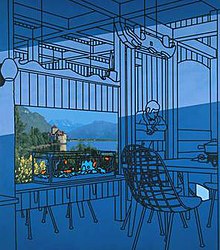Patrick Caulfield
| Patrick Caulfield | |
|---|---|

After Lunch, 1975, Tate Gallery
|
|
| Born |
Patrick Joseph Caulfield 29 January 1936 Acton, Middlesex, England |
| Died | 29 September 2005 (aged 69) London, England |
| Nationality | British |
| Education |
Chelsea School of Art, 1956–1959 Royal College of Art, 1960–1963 |
| Known for | Painting, Printmaking |
| Notable work |
After Lunch, 1975 Still Life with Dagger, 1963 Les Demoiselles d'Avignon vues de derrière, 1999 |
| Awards |
Prix des Jeunes Artistes, 1965 Royal Academician, 1993 Jerwood Painting Prize, 1995 London Institute Honorary Fellowship, 1996 Commander of the Order of the British Empire, 1996 |
Chelsea School of Art, 1956–1959
After Lunch, 1975
Still Life with Dagger, 1963
Prix des Jeunes Artistes, 1965 Royal Academician, 1993 Jerwood Painting Prize, 1995 London Institute Honorary Fellowship, 1996
Patrick Joseph Caulfield, CBE, RA (29 January 1936 – 29 September 2005), was an English painter and printmaker known for his bold canvases, which often incorporated elements of photorealism within a pared-down scene. Examples of his work are Pottery and Still Life Ingredients.
Patrick Joseph Caulfield was born on 29 January 1936 in Acton, west London. During the second world war Caulfield's family returned to Bolton in 1945, where his parents were born, to work at the De Havilland factory. Leaving Acton Secondary Modern at the age of 15, Caulfield secured a position as a filing clerk at Crosse & Blackwell and later transferred to the design studio, working on food display and carrying out menial tasks. At 17, he joined the Royal Air Force at RAF Northwood, pre-empting requirement for national service. Inspired by the 1952 film Moulin Rouge about the artist Henri de Toulouse-Lautrec, he spent his free time attending evening classes at Harrow School of Art (now part of the University of Westminster).
...
Wikipedia
